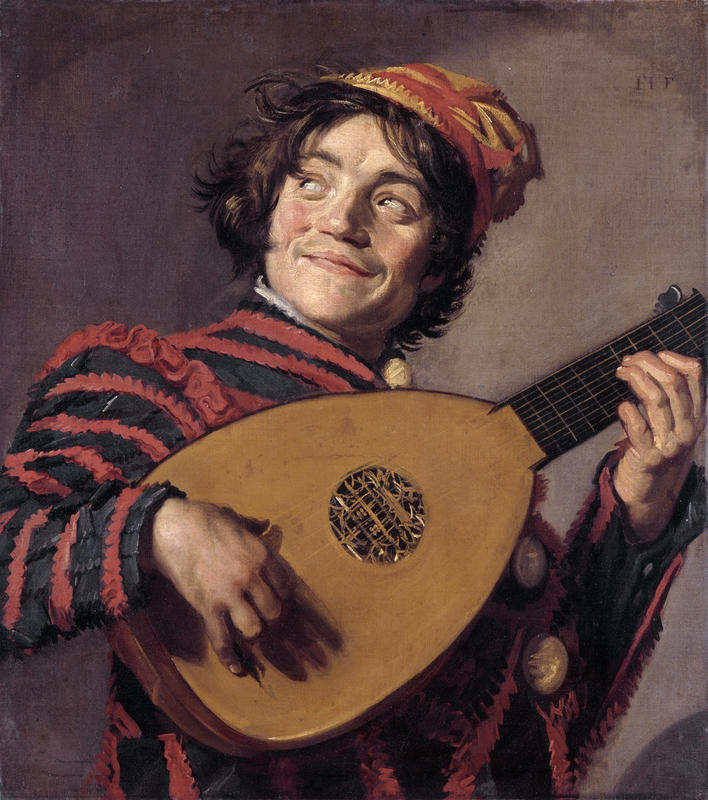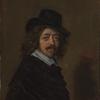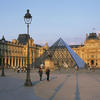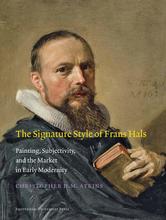More about The Lute Player
- All
- Info
- Shop

Contributor
Didn’t think a kodak moment was possible in the 17th century? Then you haven’t seen Frans Hals’s Buffoon with a Lute.
Frans Hals was the kind of artist who'd paint every kind of human roaming the streets of Haarlem. What more could you expect? It was the 17th century. Trade was booming and everyone wanted a painting.
During this period the Dutch people enjoyed a great influx of wealth, allowing even the lower classes to have paintings. Great news if you were in the painting trade during the Dutch Golden Age (1600-1750) - work was never far away. Hals never even left his neighborhood of Haarlem (except once, visiting his birth town of Antwerp in 1616) to seek out subjects. Inspiration for paintings could be found in Haarlem households, government buildings, and, you guessed it, bars. Not everyone was a fall-down drunk, though. At the time, Dutch beer had a low alcohol-content and was safer to drink than available water as it was sterilised during the brewing process. Still, the party was lit!
Enter the buffoon: an unidentified man strumming away at his lute while Hals stands armed with a paintbrush, ready to capture his likeness forever. Buffoon with a Lute looks like something out of that raging party we weren’t invited to. Looking at the buffoon, you wouldn’t believe the painting took place in a studio but instead in a tavern of some sort.
Hals superbly captured the personality of his clientele rather than keeping them stiff. Expressionless portraits were not Hals’ style. Evidence of sketches in reference to Hals’ paintings hardly exist. Hals worked straight on the canvas with the intention capturing a fleeting moment, rather than to labor over the study for weeks. Haarlem’s most wealthy as well as the common Dutchman/woman all knew Hals. They flocked to the artist, wanting him to captured sentimental moments. Civic servants, housewives, musicians, teeny tiny little children, gypsies, the list goes on because Hals really got around. With a paintbrush, I mean.
I wouldn’t mind me a portrait of a jolly, lively man strumming away as though in a bar. It looks like he’s having a grand old time.
Sources
- Allen, Brian T., “The Juicy, Joyous Works of Frans Hals,” National Review. March 30 2019. Accessed August 5 2019 https://www.nationalreview.com/2019/03/frans-hals-art-show-vivid-portra…
- Dobrzynski, Judith H., “’Frans Hals Portraits: A Family Reunion’ Review: Piecing Together the Van Campen Clan,” The Wall Street Journal. October 20, 2018. Accessed August 14, 2019 https://www.wsj.com/articles/frans-hals-portraits-a-family-reunion-revi…
- Emmer, Pieter Cornelis, Ulijaszek, Stanley, The Dutch Slave Trade, 1500-1850, New York:Berghahn Books, 2005.
- Karabell, Shellie, “Lessons from the Dutch Golden age: What Really Makes a Nation Great,” Forbes, December 25, 2017. Accessed August 20, 2019 https://www.forbes.com/sites/shelliekarabell/2017/12/25/lessons-from-th…
- Paul, Richard. "The Shock of the Old: At the National Gallery, Unprecedented Portraits by Dutch Master Frans Hals Frans Hals." The Washington Post (1974-Current File), Oct 01, 1989. Accessed August 7, 2019 http://ezproxy.slv.vic.gov.au/login?url=https://s
- Rijksmuseum, “Young Man Playing the Lute.” Accessed August 29 2019. https://rkd.nl/en/explore/images/18120
- Schjeldahl, Peter, “Haarlem Suffle: The Art World,” The New Yorker, Vol. 87, no. 23.
- Walsh, David, “Frans Hals Portraits: A Family Reunion at the Toledo Museum of Art,” World Socialist Web Site. January 17, 2019. Accessed August 5, 2019. https://www.wsws.org/en/articles/2019/01/17/hals-j17.html
- Westermann, Mariet, A Worldly Art: The Dutch Republic, 1585-1718. London: Laurence King Publishing, 2004.
Featured Content
Here is what Wikipedia says about The Lute Player (Hals)
The Lute Player is an oil-on-canvas painting from 1623 or 1624 now in the Louvre by the Haarlem painter Frans Hals, showing a smiling actor wearing a jester's costume and playing a lute.
This painting was documented by Wilhelm von Bode in 1883, Ernst Wilhelm Moes in 1909 and Hofstede de Groot in 1910, who wrote:
98. A FOOL WITH A MANDOLINE. B. 45; M. 216.- Half-length. A man turned half-right, in a red costume trimmed with yellow. He has long hair, and wears a red and yellow cap. His head is seen in full face; he looks up to the left. With his right hand he touches the strings of a mandoline; his left hand grasps the neck. Very freely handled. Especially good are the various contrasting flesh-tones, the red and yellow of the costume, and the reflections in the eyes. [Compare 95.] Signed in the right at top, F. H.; canvas, about 29 inches by 24 inches. A copy (B. 16, and see M. 216) is in the Rijksmuseum, Amsterdam, 1907 catalogue, No. 1093; it measures 26 inches by 24 inches, having rather less at the foot than the original. In the collection of Baron Gustave de Rothschild, Paris.
The theme of a lute player painted at half length originated in Italy, and the Dutch painter Dirck van Baburen first introduced this theme in the Northern Netherlands with his lute player of 1622. Baburen's player is pointing his lute towards the viewer with his mouth open in song. Hals' player is looking up and smiling naturally, as if he is playing with a singer or another musician not in view. This painting is a good example of Hals' "rough style" of painting with loose brush strokes.
A period copy now in the collection of the Rijksmuseum has been dated before 1626 based on an engraving, and it has been attributed variously to Hals, his brother Dirk, and Judith Leyster.
Two other paintings of lute players by Hals are:
Hals was not the only painter to be influenced by Baburen. Hendrik ter Brugghen painted several lute players in the 1620s, and a few of them seem to merge aspects of Baburen and Hals, though his later version seems to follow Hals more closely.
-
"First" Lute player by Baburen in 1622
-
1624 Lute player by Hendrick ter Brugghen
-
1628 Lute player by Hendrick ter Brugghen
-
1629 Serenade by Judith Leyster
Check out the full Wikipedia article about The Lute Player (Hals)













